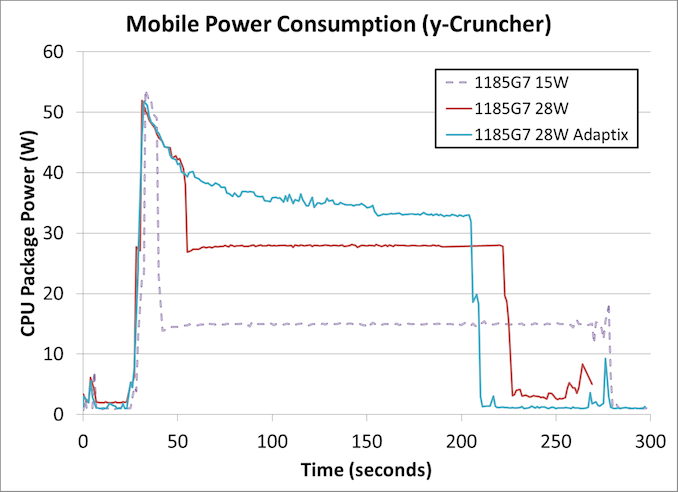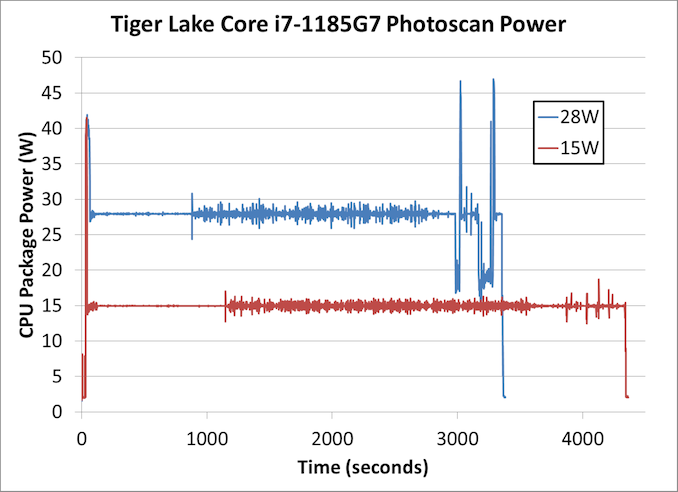Intel’s Tiger Lake 11th Gen Core i7-1185G7 Review and Deep Dive: Baskin’ for the Exotic
by Dr. Ian Cutress & Andrei Frumusanu on September 17, 2020 9:35 AM EST- Posted in
- CPUs
- Intel
- 10nm
- Tiger Lake
- Xe-LP
- Willow Cove
- SuperFin
- 11th Gen
- i7-1185G7
- Tiger King
Comparing Power Consumption: TGL to TGL
On the first page of this review, I covered that our Tiger Lake Reference Design offered three different power modes so that Intel’s customers could get an idea of performance they could expect to see if they built for the different sustained TDP options. The three modes offered to us were:
- 15 W TDP (Base 1.8 GHz), no Adaptix
- 28 W TDP (Base 3.0 GHz), no Adaptix
- 28 W TDP (Base 3.0 GHz), Adaptix Enabled
Intel’s Adaptix is a suite of technologies that includes Dynamic Tuning 2.0, which implements DVFS feedback loops on top of supposedly AI-trained algorithms to help the system deliver power to the parts of the processor that need it most, such as CPU, GPU, interconnect, or accelerators. In reality, what we mostly see is that it reduces frequency in line with memory access stalls, keeping utilization high but reducing power, prolonging turbo modes.
Compute Workload
When we put these three modes onto a workload with a mix of heavy AVX-512 compute and memory accesses, the following is observed.
Note that due to time constraints this is the only test we ran with Adaptix enabled.
This is a fixed workload to calculate 2.5 billion digits of Pi, which takes around 170-250 seconds, and uses both AVX-512 and 11.2 GB of DRAM to execute. We can already draw conclusions.
In all three power modes, the turbo mode power limit (PL2) is approximately the same at around 52 watts. As the system continues with turbo mode, the power consumed is decreased until the power budget is used up, and the 28 W mode has just over double the power budget of the 15 W mode.
Adaptix clearly works best like this, and although it initially follows the same downward trend as the regular 28 W mode, it levels out without hitting much of a ‘base’ frequency at all. Around about the 150 second mark (120 seconds into the test), there is a big enough drop followed by a flat-line which would probably indicate a thermally-derived sustained power mode, which occurs at 33 watts.
The overall time to complete this test was:
- Core i7-1185G7 at 15 W: 243 seconds
- Core i7-1185G7 at 28 W: 191 seconds
- Core i7-1185G7 at 28 W Adaptix: 174 seconds
In this case moving from 15 W to 28 W gives a 27% speed-up, while Adaptix is a total 40% speed-up.
However, this extra speed does come at the cost of total power consumed. With most processors, the peak efficiency point is when the system is at idle, and while these processors do have a good range of high efficiency, when the peak frequencies are requested then we are in a worst case scenario. Because this benchmark measures power over time, we can integrate to get total benchmark power consumed:
- Core i7-1185G7 at 15 W: 4082 joules
- Core i7-1185G7 at 28 W: 6158 joules
- Core i7-1185G7 at 28 W Adaptix: 6718 joules
This means that for the extra 27% performance, an extra 51% power is used. For Adaptix, that 40% extra performance means 65% more power. This is the trade off with the faster processors, and this is why battery management in mobile systems is so important - if a task is lower priority and can be run in the background, then that is the best way to do it to conserve battery power. This means things like email retrieval, or server synchronization, or thumbnail generation. However, because users demand the start menu to pop up IMMEDIATELY, then user-experience events are always put to the max and then the system goes quickly to idle.
Professional ISV Workload
In our second test, we put our power monitoring tools on Agisoft’s Photoscan. This test is somewhat of a compute test, split into four algorithms, however some sections are more scalable than others. Normally in this test we would see some sections rely on single threaded performance, while other sections use AVX2.
This is a longer test, and so the immediate turbo is less of a leading factor across the whole benchmark. For the first section the system seems content to sit at the respective TDPs, but the second section shows a more variable up and down as power budget is momentarily gained and then used up immediately.
Doing the same maths as before,
- At 15 W, the benchmark took 4311 seconds and consumed 64854 joules
- At 28 W, the benchmark took 3330 seconds and consumed 92508 joules
For a benchmark that takes about an hour, a +30% performance uplift is quite considerable, however it comes at the expense of +43% power. This is a better ratio than the first compute workload, but still showcases that 28 W is further away from Tiger Lake’s ideal efficiency point.
Note that the power-over-time graph we get for Agisoft on a mobile processor looks very different to that of a desktop processor, as a mobile processor core can go above the TDP budget with fewer threads.
This leads to the dichotomy of mobile use cases with respect to the marketing that goes on for these products - as part of the Tiger Lake launch, Intel was promoting its use for streaming, professional workflows such as Adobe, video editing and content creation, and AI acceleration. All of these are high-performance workloads, compared to web browsing or basic office work. Partly because Tiger Lake is built on the latest process technology, as well as offering Intel’s best performing CPU and GPU cores, the product is going to be pitched in the premium device market for the professionals and prosumers that can take advantage.












253 Comments
View All Comments
JayNor - Thursday, September 17, 2020 - link
I noted from Intel's Thunderbolt 3 documents that the ports are bidirectional and can, for example, support pcie send while receiving display port on the same cable.Is it possible, for example, to use an external GPU card with one cable to display output on your laptop's display?
Spunjji - Friday, September 18, 2020 - link
I understand that you can, but it drops performance significantly.Spunjji - Thursday, September 17, 2020 - link
Oof, those GPU benchmarks are painful. It's become clear that their predictions were all based on LPDDR5PeachNCream - Thursday, September 17, 2020 - link
Yes the GPU results are somewhat disappointing, but there is only so much you can do when sharing bandwidth to RAM with the CPU cores and everything else. Of course, there is also significant latency to contend with when you don't have GDDR5/6 available to the graphics processor.Spunjji - Friday, September 18, 2020 - link
Absolutely - it's become pretty clear that's why AMD decided to go with 8 CUs on Renoir. I wasn't expecting anything huge from Xe on TGL, but Intel were pushing it as a big win and really it's just not - at least, not in this form. A ~20% bandwidth boost might well translate into big gains on later devices.JayNor - Saturday, September 19, 2020 - link
false, they used lpddr4x for the benchmarks.Spunjji - Saturday, September 19, 2020 - link
I think perhaps you misread what I said. Intel were previously showing numbers suggesting a huge leap in performance for their Xe iGPU which isn't borne out by the testing done here. I'm suggesting that it's because Intel were quoting numbers based on an LPDDR5 implementation. They could have just been lying, though. You seem to be suggesting the latter?undervolted_dc - Thursday, September 17, 2020 - link
Ok but why there are no power consumption of the ryzen ? I see a 28w tiger lake which have a peak of 50+ and an average of 35 and another "28w" tiger lake which instaed have a peak of 50+ and an average of 38w..,is the 4800u in thermal throttling because the tiger lake is better cooled ? this "reference" and the lack of real power usage comparision is "strange" to me... we started from the intel benchmarks.. and now we hare here ... where will be in 1 more months when the tiger lake will be in stores with also it's prices.. will be still comparable to the 4800u? ( and I'm also sure that asus will not cover air intake for the tiger lake one to be able to sell them against the 4800u given the higher prices they have to ask .. )
and where we will be then when zen3/cezanne will be revealed ? you will see the zen3 ipc and freq gain in 1 month.. ( maybe even before tiger lake approach stores ) .. I see no Baskin here..
undervolted_dc - Friday, September 18, 2020 - link
Also ram is unfair for this comparison:intel LPDDR4X-4266
vs amd DDR4-3200
but again.. at the end of the day the only thing that matter is the price/performance/power-usage balance for laptop, and here I see only performance comparison..(in unknown thermal/power condition for tests) and with no words about price..
we see here a coming-soon quad core intel with a power usage higher than 1 year old 8 core amd which is also faster in full speed tests ( not in gpu , but it's the old navi chip )
yes, single core bench the intel win.. but their high freq single core are 20% higher freq than AMD ones, are 20% faster, and eat 50% more power , are ~1 year newer , and probably will costs 50% more.. so who is the real winner?
undervolted_dc - Friday, September 18, 2020 - link
a mere 4500u with lpddr4x show an average +17% improvements in benchmarks..https://optocrypto.com/amd-ryzen-4000-adding-suppo...